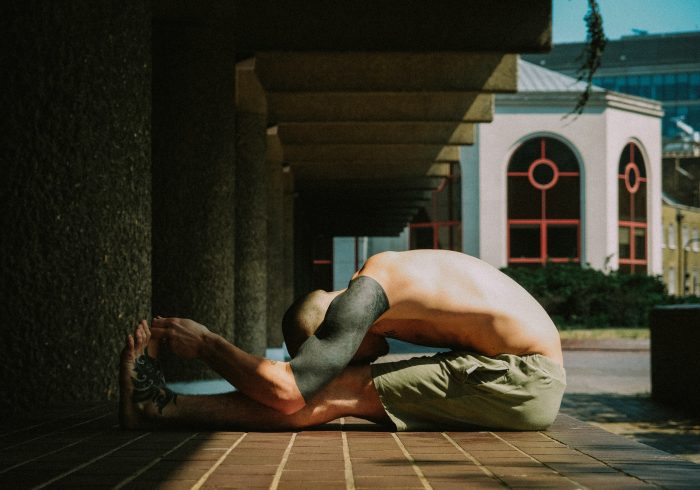Two decades ago, before I began yoga, I noticed something curious when I walked by some store windows and glanced at my reflection.
As I strode ahead, I seemed to be tilting backward, with my shoulders drifting behind my butt and my low ribs sliding out in front.
Even though my walking posture seemed a bit odd, I thought it was just the way my body was put together and just the way I walked.
But after a while, I saw that my back-tilting posture was not an isolated oddity. I also slumped down when sitting, drooped my right shoulder when standing, and, regardless of position, experienced periodic low-back pain. I was off center and out of kilter.
With the encouragement of a yoga-practicing friend—who thought yoga might help me become more at home with my physical self—I visited the main yoga studio in our town. And that began a long-term practice of coming into my body and learning from it.
Especially important to me has been learning about my spine. As I’ve explored my spine’s movements, my posture has come to feel more balanced, and my body has become a better friend.
In this article, I’d like to share three spine-centered discoveries that have meant a lot to me in yoga and beyond.
Straightening Does Not Mean Flattening
As I got started with yoga, I was quite conscious of my tendency to tilt, slouch, and droop. I was eager to straighten myself out. So, when I first began to focus on my spine, I thought pulling myself upright, like coming to attention in a military-style salute, was the ticket.
Sure, I knew the spine had curves, but spinal curves initially struck me as sort of feminine. As a guy, and one who worked out in the gym, rising up as tall as possible through the spine seemed much more important than keeping curves.
But when I overrode and flattened my spinal curves in a push upward, I simply felt more rigid. When standing, if I thrust myself straight up, lifting the top of my head as high as I could, the breadth of my mid-back, my thoracic curve, gave way to a pinching narrowness. My heart jutted forward and my chin angled up. I gained length in the front of my body but at the expense of length in my back. This felt just as out of kilter as slouching.
Gradually, I learned to lengthen my spine from within the curves rather than against them. For example, I learned to let my breath lift my spine from the back of my heart up to the back of my skull. This fostered a supple and rhythmical kind of lengthening rather than a rigid and static sort.
The idea of straightening without flattening seemed to have implications for life beyond yoga. When I felt bent out of shape emotionally, trying to straighten myself out by pushing ahead forcefully toward some new goal or self-help ideal never seemed to achieve the kind of clarity and calm confidence that I was hoping for. What worked better was to honor the curves of personal growth rather than to try to smooth out the inevitable bumps of uncertainty. The wave-like agility of the spine was a more fitting metaphor for life than a salute-like fixity of focus.
Bending Does Not Mean Collapsing
Alongside my tendency to flatten my spine’s curves was a tendency to reverse the curves with abandon when forward and back bending.
When I let my torso drape down toward the floor in what I hoped would be a relaxing forward bend, too often I completely let go of the arch in my lower back and replaced it with a strongly rounding forward curve. But when a natural spinal curve is sharply reversed, the fluidity of the spine evaporates, the energy stagnates, and muscles become strained.
This is as true for backbends as forward bends. While the normal C-shaped outward curve of the thoracic spine (the curve behind the heart) has to give way to an inward arch in order to do a backbend, if the normal curve simply collapses and is pushed into its opposite shape, the back feels cramped and stressed. With a cranky back, it’s hard to feel the heart opening that backbends are intended to foster.
I learned in forward bends to lengthen my lumbar spine, for example, by imagining puffs of air opening space between the vertebrae, before letting my lower back round. And I did something similar with my thoracic spine before allowing it to migrate to an inner arch. Creating more space in the curves enabled me to shift their shape more smoothly.
These bending actions and insights have carried over into my life.
The lesson about forward bending reminds me that when I’m relaxing into a place of ease, like an old comfy chair, it’s good to preserve a degree of lift and lightness in my low back. I feel more in harmony with myself when I fold inward with gentle alertness instead of simply collapsing down. More broadly, I’m reminded that being at ease does not mean that I let go of cares and interests so completely that I fall asleep.
With backbends, the play of spinal curves reminds me that when I’m opening my heart to the world and unfolding my energy outwardly, I shouldn’t forget about what’s happening inwardly. Even if I bend over backward to meet others’ needs or adapt to a new situation, it’s still important to check in with my deepest self and listen to what my soul wants to say.
Wagging Opens More Possibilities than Mere Tucking
Here, I’m referring to wagging my tailbone, the bottommost segment of the spine, in different directions, compared with tucking my tailbone, a one-directional action.
Wagging is a relatively new practice for me. Before imagining my tailbone wagging playfully, like a cat’s tail, I rarely thought of my tailbone at all. And when I did think of it, I associated it with the instructional cue I heard long ago to “tuck the tailbone.”
In retrospect, I think the instruction to tuck the tailbone was given to help those of us who might overarch our lower back and tilt the pelvis too far forward to bring the pelvis into alignment.
But when I encountered the tail-tucking cue, I must have overgeneralized it because I started seeing a tucked tail as an end in itself, a kind of preferred and fixed destination.
I’ve since learned that not only can I tuck my tail toward my pubic bone, but I can unfurl and lengthen it away from this bone and wiggle it to the sides toward the sit bones. The tailbone moves very little, but with imagination and the breath, it’s possible to wag my tail in an exploratory and interesting way.
For example, in Downward Facing Dog, when I unfurl my tail to the wall behind me, I feel energy percolating in the widening space between my sit bones and a lengthening of my spine. When I experiment with simultaneously drawing my pubic bone toward my tailbone and my tailbone toward my pubic bone, I sense a sweet spot between the bones where energy pulses upward. Wagging my tail within the bowl of my pelvis rather than simply tucking it in enlivens my Down Dog and gives it an extra spark.
This wagging tailbone practice is an embodied reminder of two things for me. One is that being open to playful possibilities in life feels more engaging, enjoyable, and growth-supporting than closing in on one set action.
The other is that small actions out of the limelight can make a big difference. Nodding the tailbone backward, forward, and to the sides is a subtle movement pattern that can infuse poses with greater vitality. So, too, in life, we don’t need to rely on sweeping, dramatic actions to make a difference. Small, everyday acts of service and kindness, for instance, can matter as much as, and sometimes even more than, the bold and highly visible gesture.
The spine is a wondrous structure of grace, flexibility, and strength. When we let ourselves learn from it and find harmony with its curves, we might discover more joy in yoga and more wholeness in our lives.
Acknowledgment: The ideas in this article would not have come to me without the instruction and wisdom of two marvelous yoga teachers: Leslie Ellis and Lani Jelen.












Read 6 comments and reply